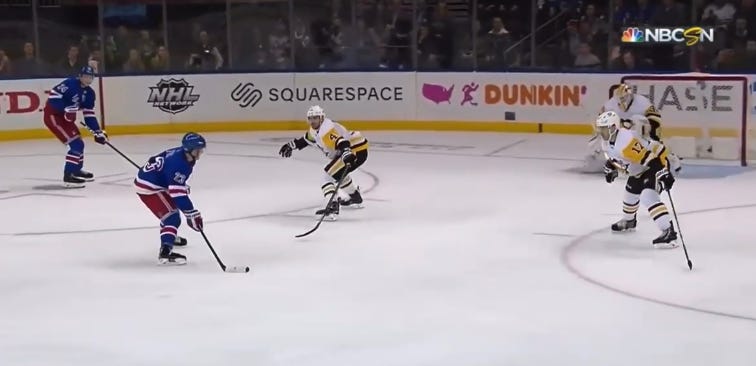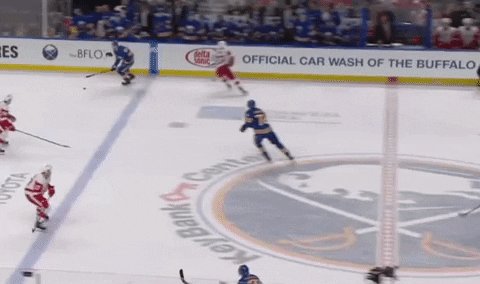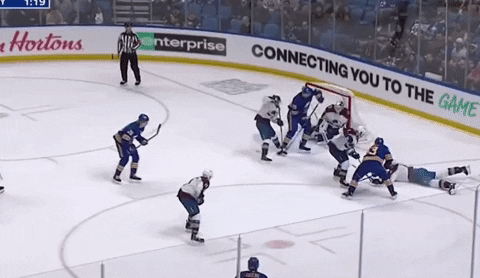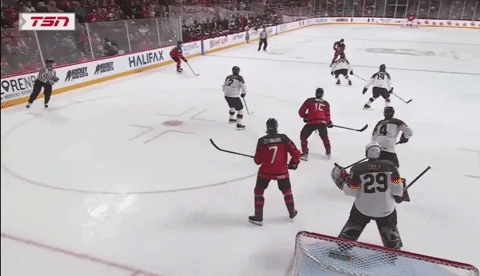Creating Better Offense by Allowing the Best Play to Present Itself
Make Him Make The First Move, Conway!
Before we dig in, we are pleased to introduce a new ‘refer a friend. program’ If you refer new Hockey IQ Newsletter subscribers, you will be rewarded with an upgrade to our supporter-level access.
Refer your linemates (two people) = 3 months access to supporter
Refer your starting lineup (five people) = 6 months access to supporter
Refer your team (20 people) = 12 months access to supporter
Every situation in a hockey game is a strategic interaction between opponents. Every coach and scout talks about finding smart problem-solvers. For me, what we really want from offensive players is actually problem-creators.
Finding ways to put the defending players in adverse situations is an offensive player’s dream. There is nothing better than presenting a problem to a defender while having a great solution no matter which choice they make.
The Mighty Ducks Had A Point
While the ‘Mighty Ducks’ movies are very cheesy… there are a few valid points made. In the third movie, in particular, we see the team being pushed to mature by their new head coach.
One of the lessons highlighted in the film is how the coach tells newly converted defenseman Charlie Conway: “Make him make the first move, Conway!”
If the attacking player makes the first move and commits, the defenseman can easily counter and stifle him. Eager to quickly make the turnover and head to offense, Conway struggled to be patient and constantly ‘made the first move’. This resulted in him getting beat with consistency.
Reverse engineering this for offensive hockey, how can we force the defender to make the first move and decisions for us as attackers?
Dual Threat
The dual-threat position in hockey is puck positioning where a puck carrier can easily either carry the puck or release a shot/pass. Setting up a dual threat with the puck carried on a player’s “hip pocket” forces the opposition to respect your options.
To best play out a strategic interaction, the offense uses a dual threat puck positioning posture to put a defending player in a situation where they must make a decision while having a solution available regardless of the defender’s decision.
This leaves an impossible dilemma for the defenders.
Make Him Make the First Move
Elite offensive players are putting defensemen in situations where they have to make decisions and effectively make the first move. Once committed, the attacker takes what is left available and creates offense.
These attacking players are holding the puck in a simple dual-threat posture then reading what the defense chooses then doing the opposite. They let the play and the best decision unfold in front of them. The defender’s decision makes up the attacker’s next move.
Often, less-developed attacking players play too fast and rush through the game and their offensive chances. The more developed attacking players have evolved to a point where they let the game unfold in front of them.

Buffalo Sabres & Tage Thompson
The Sabres have a number of players like Rasmus Dahlin, Alex Tuch, and Tage Thompson who excel at this concept. I can almost hear Donny Granato preaching this in practice.
Watch below as Dahlin shows this dual threat as he holds the puck on his hip as though he is going to shoot. The defender goes down in a shot-blocking position to take that away. He simply pulls the puck around the defender.
Thompson similarly holds the puck in a shooting position. The defender goes down in a shot-blocking position while blocking the passing lane. Tage pulls the puck in and shoots.
Here, Thompson holds the puck in a shooting position. The goalie drops his near leg to start pushing across to cover the backhand deke. Thompson reads this and shoots nearside to score.
Finally, Thompson holds the puck in a shooting position. He dekes around one defender, then notices the second defender quickly moving into his space and passes for an assist.
Not only does this work well against skaters, this also works great against goalies, too! Particularly those that come out to challenge the shooter.
Connor Bedard WJC
Another player who is very adept at this… Connor Bedard.
Watch his semifinal goal against Slovakia at the WJC. He sets up perfectly in a dual-threat position. Once the defender chooses to respect his shot and go down for a block, Bedard goes right around him with a simple stickhandle.
Two clips that marry together well are from Bedard’s game vs. Germany. First clip, the dual-threat position forces a decision on the defending team. Once they decide to take one option away, Bedard goes for what is left. In this case… pass is the best play.
What’s even more interesting is his goal before that assist… a very similar situation, but Germany takes away the pass. Bedard then whizzes a shot past the goalie.
Bedard sets up the situation and makes the best play available. Is this simple? Absolutely. Is this common? Nope.
Players need to resist the urge to “play fast” and allow the game to unfold. Create an advantageous situation then allow the defenders to make the first move.
Further Reading
Buffalo Sabres Players Walking Through Their Film with “Tablet Talk”
How Shooters Are Fighting Back Against Goalies to Score More Goals














